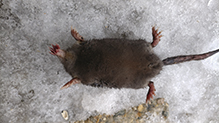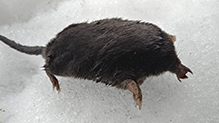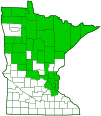Star-nosed Mole
(Condylura cristata)
Conservation • Description • Habitat • Ecology • Distribution • Taxonomy

Conservation Status
IUCN Red List
LC - Least Concern
NatureServe
N5 - Secure
SNR - Unranked
Minnesota
not listed
Description
Star-nosed Mole is a relatively common but seldom seen New World mole. It occurs in North America from Newfoundland to Pennsylvania, west to Ontario and Minnesota, and south along the Appalachian Mountains to North Carolina. It is less common in Minnesota, where it is at the western extent of its range.
The fur (pelage) is coarse, thick, and dark brown or black with no silvery sheen.
The tail is hairy, 3″ to 3½″ long, and constricted near the body.
The front feet are as long as broad. The palms face outward.
The eyes are small, about the size of a pinhead, but apparent, not covered by skin. There are no external ears. The nose is pink and is surrounded by 22 pink, fleshy, finger-like projections, giving it a star-like appearance.
Size
Total length: 6⅞″ to 8″
Head and body: 4½″ to 5″
Tail: 3″ to 3½″
Sign
Similar Species
Eastern Mole (Scalopus aquaticus) is larger but has a shorter tail and so is about the same total length. The pelage is lighter and has a silvery sheen. The nose is long, naked, and pointed, and has no finger-like appendages.
Habitat
Meadows, floodplains, swamps, marshes, and peatlands. Moist soil. Usually near a water body.
Ecology
Behavior
They are active day and night.
Lifespan
3 to 4 years
Life Cycle
The female has one litter of 3 to 7 young between April and June. The offspring are independent after 3 weeks. They mature in 10 months.
Food
Small invertebrates, earthworms, aquatic insects, mollusks, and small amphibians.
Distribution |
||
|
Sources Biodiversity occurrence data published by: Minnesota Biodiversity Atlas (accessed through the Minnesota Biodiversity Atlas Portal, bellatlas.umn.edu, 12/19/2025). Timm, R. M. 1975. Distribution, natural history, and parasites of mammals of Cook County, Minnesota. Occasional Papers, Bell Museum of Natural History, University of Minnesota 14:1–56. Hazard, Evan B. 1982. The Mammals of Minnesota. University of Minnesota Press, Minneapolis, Minnesota. 280 pp. The counties in light green lack modern records but have historic county or township specimens or records. |
|
| 12/19/2025 | ||
Occurrence |
||
Relatively common |
||
Taxonomy
Class
Subclass
Theria
Infraclass
Placentalia (Placental Mammals)
Magnorder
Boreoeutheria
Superorder
Laurasiatheria (Ungulates, Carnivorans, and Allies)
Order
Eulipotyphla (Shrews, Moles, Hedgehogs, and Allies)
Suborder
Erinaceota (Shrews, Moles, and Hedgehogs)
Superfamily
Talpoidea
Family
Talpidae (Moles and Desmans)
Subfamily
Talpinaei (New World Moles)
Tribe
Condylurini (Star-nosed Moles)
Genus
Condylura
Subordinate Taxa
Northern Star-nosed Mole (Condylura cristata cristata) ![]()
Southeastern Star-nosed Mole (Condylura cristata parva)
Synonyms
Sorex cristatus
Common Names
Star-nosed Mole
Starnose Mole
Glossary
Pelage
The coat of a mammal, consisting of fur, wool, or hair, and including a soft undercoat and stiff guard hairs.
Visitor Photos
Share your photo of this mammal.
This button not working for you?
Simply email us at info@MinnesotaSeasons.com.
Attach one or more photos and, if you like, a caption.
Gerry G |
||
 |
 |
|
MinnesotaSeasons.com Photos
|

Slideshows

Visitor Videos
Share your video of this mammal.
This button not working for you?
Simply email us at info@MinnesotaSeasons.com.
Attach a video, a YouTube link, or a cloud storage link.
Other Videos
Mammals of the World: Star-nosed Mole
cre8ivmind
Is This the World's Weirdest-Looking Killer? | World's Deadliest
Nat Geo WILD
Starnose Mole (Talpidae: Condylura cristata) Dead on Footpath
Carl Barrentine

Visitor Sightings
Report a sighting of this mammal.
This button not working for you?
Simply email us at info@MinnesotaSeasons.com.
Be sure to include a location.
M Reigstad
6/13/2022
Location: Ham Lake
My dog found it in my garden. Worried that it may carry disease.
Field Notes
6/15/2021
Location: Carver Park, Carver County
Found on path near a stream. No signs of injury. Perhaps an off-leash dog?
Lisa Wiersma
1/22/2020
Location: Erskine, MN (Polk County)
These are common in my backyard. I usually see them at least once a year over the last 10 years.
Minnesota Seasons Sightings






